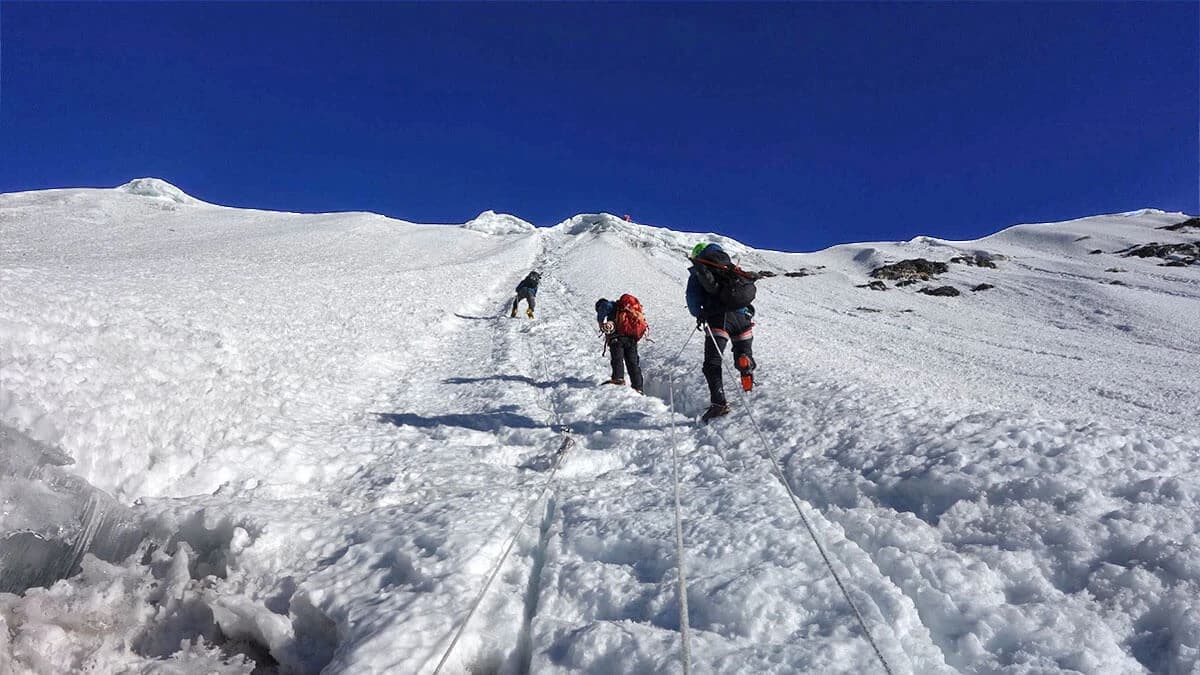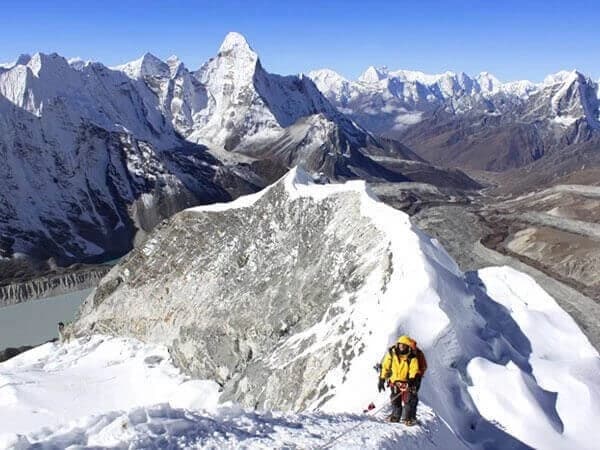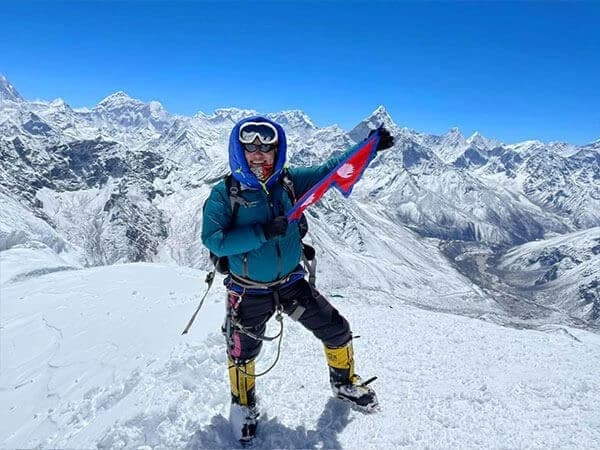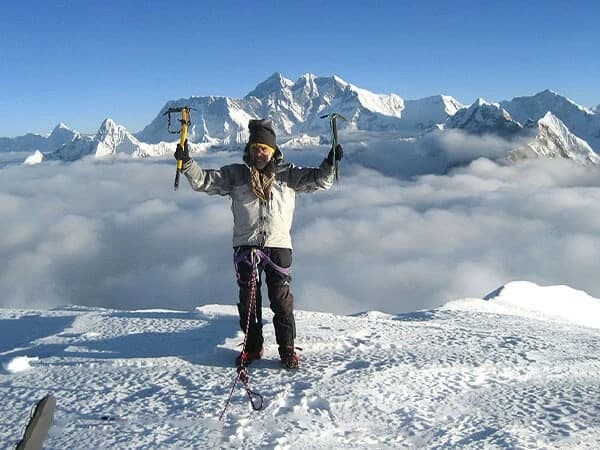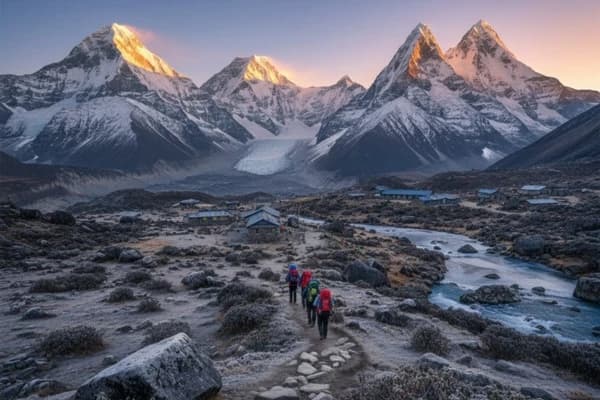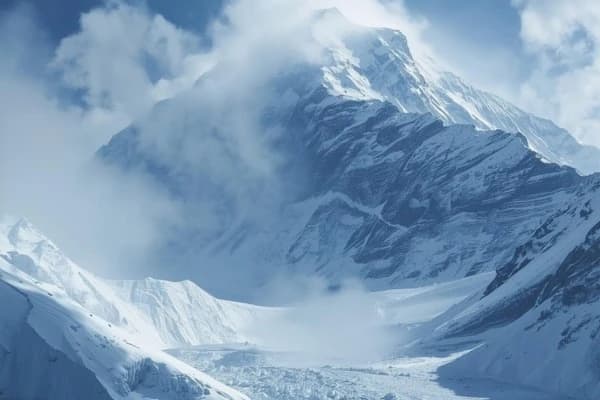Five popular trekking peaks in Nepal for beginners are Island Peak, Chulu East Peak, Pisang Peak, Lobuche East, and Mera Peak. Here, you will get complete information about climbing these peaks while you are doing a trek in the Annapurna and Everest regions.
Five Popular Trekking Peaks in Nepal
There are over 13,000 peaks above 6000 m in Nepal, of which 602 have been opened as climbing routes by the Government of Nepal and the Department of Tourism.
I like mountains because they make me feel small, ’‘They help me sort out what’s important in life.”― Mark Obmascik.
Trekking Peaks in Nepal
Nestled in the lap of the Himalayas, Nepal has the most alluring mountains on this planet. For many years, it has been a paradise for travelers, trekkers, explorers, and mountaineers alike.
We have put together five of the most popular trekking peaks that are relatively easy and not too technical. Everest is the dream, but you do not have to be a skilled climber to have your own experience; standing on top of one, we promise, is something very special.
As you are fit with a good degree of stamina, these peaks are all achievable. With highly experienced Nepal Gateway Trekking Sherpa mountain guides, you can feel secure in the knowledge you are in safe hands.
What is Trekking Peak?
Trekking peak means anyone can climb a peak while doing a trek. There are 18 trekking peaks in Nepal under the Nepal Mountaineering Association. These peaks are all over 6,000 meters to 6,500 meters. Previous climbing experience and climbing techniques are not required to climb any trekking peaks in Nepal. The famous trekking peaks to climb in Nepal are Island Peak, Lobuche Peak, and Mera Peak. These peaks are in the Everest region.
Usually, climbing a peak takes around three days.
- Day 1. Island Peak Base Camp.
- Day 2. Island Peak High Camp.
- Day 3. Summit and return to either High Camp or Base Camp.
Remember, your journey begins with your first step. Whatever peak you choose, you will trek in the world’s finest mountain scenery. So, let’s get high in the Himalayas! Once on the summit, the personal feeling of success, coupled with the best mountain views anywhere in the world, defies adequate description.

Five Popular Trekking Peaks in Nepal
Mera Peak (6,476 m)
Trip Facts
- Duration: 13 to 20 days (depending on the trek route you go)
- Altitude: 6,476 m/21,247 ft
- Climbing Days: 1 day
- Location: Makalu Barun National Park
- Best Season: Autumn (September to November) and Spring (March to May)
- Accommodation: Local teahouse during trekking and camping during climbing
Nepal’s highest trekking peak is an absolute favorite for novice climbers, and understandably so. It is an excellent option for anyone who is fit and has moderate mountaineering experience. The challenge is mainly altitude; the technical mountaineering skills required are minimal.
The trail to Mera Peak is stunning. It passes through the pristine Hinku Valley, an isolated and less visited area within the Makalu Region.
Flying into the airstrip of Lukla, it is normally an eight-day trek to Mera Base Camp (5300 m) on a trail that provides excellent acclimatization. Normally a day is spent here adjusting to the altitude. The following day, high camp is set up at 5,800 m, near a rocky outgrowth on Mera Glacier.
Followed by the summit attempt, once on, the views are truly outstanding as you gaze out across a large stretch of the Himalayas. Five 8,000m peaks are visible, including Mt. Everest (8848m), Mt. Lhotse (8516m), Mt. Cho Oyu (8201m), Mt. Makalu (8463m), and Mt. Kanchenjunga (8586m).
Two Good Peaks to compliment an Everest Base Camp Trek
Island Peak / Imja (6,189 m): Everest Region
Trip Facts
- Duration: 10 to 20 days (depending on the route you take)
- Altitude: 6,189 m/20,305 ft
- Climbing Days: 1 day
- Location: Everest Region
- Best Season: Autumn (September to November) and Spring (March to May)
- Accommodation: Local Teahouse during trekking and camping during climbing
High up amongst the high stuff, in the Everest Region, Island Peak is another fine gem for climbers wanting a moderate but challenging climb in Nepal. Island Peak is an excellent peak to build on and confirm your alpine skills. The summit offers excellent views of Nuptse (7,879 m), Lhotse (8,516 m), Lhotse Middle Peak (8,410 m), and Lhotse Shar (8,383 m).
More technical than Mera, it is convenient if you have some previous experience and knowledge about equipment, particularly gears, rock and ice climbing, and abseiling. You will be roped up on the steep latter stages with a glacier and several crevasses to negotiate.
To reach base camp, head back down from Everest Base Camp along the trail to Dingboche, up the Imja Khola Valley towards Chukhung, and on to Island Peak. There is usually a pre-summit training day provided at base camp. The next day, make the summit attempt and return to Chukhung the same day. Usually, from Chuckung, the next stop is Phortse, then on to Monjo, and then on to Lukla.

Lobuche East (6119 m)
Trip Facts
- Duration: 18 days
- Altitude: 6,119 m/20,076 ft
- Climbing Days: 1 day
- Location: Everest Region
- Best Season: Autumn (September to November) and Spring (March to May)
- Accommodation: Local Teahouse during trekking and camping during climbing
Situated deep in the heart of the Khumbu Everest region, Lobuche Peak has two distinct summits—Lobuche East (6119 m) and Lobuche West (6145 m).
The climb of Lobuche Peak is more challenging than either Mera Peak or Island Peak. It is a peak that requires a good deal of commitment. Some experience on snow, walking with an ice axe, and using crampons and fixed ropes is required.
Most companies provide basic skill training before the summit, but think twice if you have had no past high-altitude experience. With stamina and personal will, there is a strong likelihood you will succeed. Lobuche Peak is an ideal “add-on” to any trip to Everest Base Camp. It was used for many years past by climbers attempting Mount Everest as a warm-up climb.
Getting to Lobuche means heading down the trail to Lobuche for overnight. You then follow a trail along the Lobuche glacier and high camp. Training is provided at the high camp. Attempt the climb the next day; the rewards are surreal: magnificent views of Everest (8848 m), Lhotse (8516 m), Nuptse (7861 m), Ama Dablam (6812 m), Cholatse (6440 m), Pumori (7161 m), and many more before heading down to high camp and overnight. The following day, head down to Pangboche and on to Namche Bazaar.
Chulu East (6584 m)
Trip Facts
- Duration: 14 days
- Altitude: 6584 m/21,601 ft
- Climbing Days: 1 day
- Location: Annapurna Region
- Best Season: Autumn (September to November) and Spring (March to May)
- Accommodation: Local Teahouse during trekking and camping during climbing
Chulu East (6584 m) is technically not a rugged peak. However, you should have some high-altitude experience. It helps if you are familiar with crampons, harnesses, ice axes, and handling climbing ropes.
A gratifying challenge, it is another peak ideal for people who want to expand their basic alpine skills. The summit offers superb and dramatic mountain views deep in the spine of the Annapurna Region. The climb involves crossing a glacier and a steep ascent to the summit, which often means being roped together.
From the summit, the views are some of the most spectacular in Nepal. Gaze over superb vistas high above the Manang Valley, Annapurna II (7937 m), III (7555 m), and IV (7525 m), Gangapurna (7455 m), Glacier Dome (7069 m), Dhaulagiri (8167 m), Tilicho Peak (7134 m), and Manaslu (8163 m).
Combined with Annapurna Circuit
Mount Chulu East is situated off the epic Annapurna Circuit trail. Trek through subtropical lower reaches to begin, along terraced fields punctuated with small settlements. You travel on into lush rhododendron and pine forests with fantastic views a lot of the way as you make your way into the upper valley. Here the region changes significantly; the influence of Buddhism is very apparent with ancient monasteries and hardy, weathered mountain people.
On reaching the village of Pisang, you need to branch off into a more remote region. Start walking a ridge, through pine forests and yak pastures, on the way to base camp. The camp is located on a ridge separating the East and the Far East peaks of Chulu. Two days are recommended to acclimatize, while climbing teams need to prepare a high camp (Camp I). One night is spent at high camp before the ascent to the summit and the return to base camp the next day.
The following two days are spent on the descent to Manang through juniper forests. Most people from here take the trail over the Thorang La (5416 m) and down to the pilgrimage site of Muktinath. From Muktinath, it is a short descent to Jomsom. The majority of people end their trek here, either by taking a flight to Pokhara or a jeep via Beni.

Pisang Peak (6019 m)
Trip Facts
- Duration: 14 days
- Altitude: 6,091 m/19,984 ft
- Climbing Days: 1 day
- Location: Annapurna region
- Best Season: Autumn (September to November) and Spring (March to May)
- Accommodation: Local Teahouse during trekking and camping during climbing
Another good peak, situated on the classic Annapurna Circuit, is Pisang Peak, a popular trekking peak in Nepal. It is not a difficult peak to climb, but one hard to match for its rugged mountain scenery. Rising across from Annapurna II (7937 m) and neatly placed opposite the giants of Annapurna I (8091 m) and Manaslu (8163 m), it’s a great introduction to Himalayan peak climbing.
Most people combine the climb of Pisang Peak with the Annapurna Circuit trek. From the summit the Annapurna Range Tilicho Peak, Annapurna II and IV, Gangapurna and the Glacier Dome reach to touch you.
Begin on the Annapurna Circuit Trail, with a refreshing few days along the Marshyangdi Valley. This trail is quite special, one that provides lush oak and pine forests, ancient settlements, and some great mountain views. Higher up the valley, you enter a beautiful alpine region, where you are surrounded by magnificent peaks all the way to Pisang.
From Pisang, head north through sparse wood and yak pasture to Kharka village (4,380 m). Base Camp is made here. The following day, a high camp is made at 5,400 m on the South-West Ridge. On the summit day, you follow a well-defined ridge that leads to a final steep climb to the summit before returning to Base Camp.
From the summit, the rewards are tremendous. Mt. Dhaulagiri (8167 m), Mt. Manaslu (8163 m), and Mt. Annapurna (8091 m) all play their part in a superb mountain backdrop. The following days are spent trekking down to Manang to join the main trail, mainly for the traverse of the Thorang La (via Thorung Phedi) to the holy town of Muktinath. From Muktinath, it is an easy trek to Jomsom, where you can take a flight to Pokhara or continue your journey.
Summing Up
Finally, Nepal has become a unique trekking destination, full of appropriate peaks for beginners and experienced climbers. The five most desired trekking summits, Island Peak, Chulu East, Pisang Peak, Lobuche East, and Mera Peak, will give trekkers opportunity to see the magnificence of Himalayas with little climbing skills. In addition to the fantastic views from atop these peaks, climbers also experience the genuine culture that is found all over the area. Participation in these treks reveals the actual spirit of trekking in Nepal; the best of both worlds with its spectacular landscape, cultural legacy, and personal satisfaction.
While exploring the majestic trekking peaks of Nepal, don’t miss the chance to enjoy the Top Five Day Hikes Around Kathmandu Valley, offering scenic trails and cultural experiences just a short distance from the capital.
Also read our article on, Best Six Handpicked Trekking and Climbing Packages in Nepal
